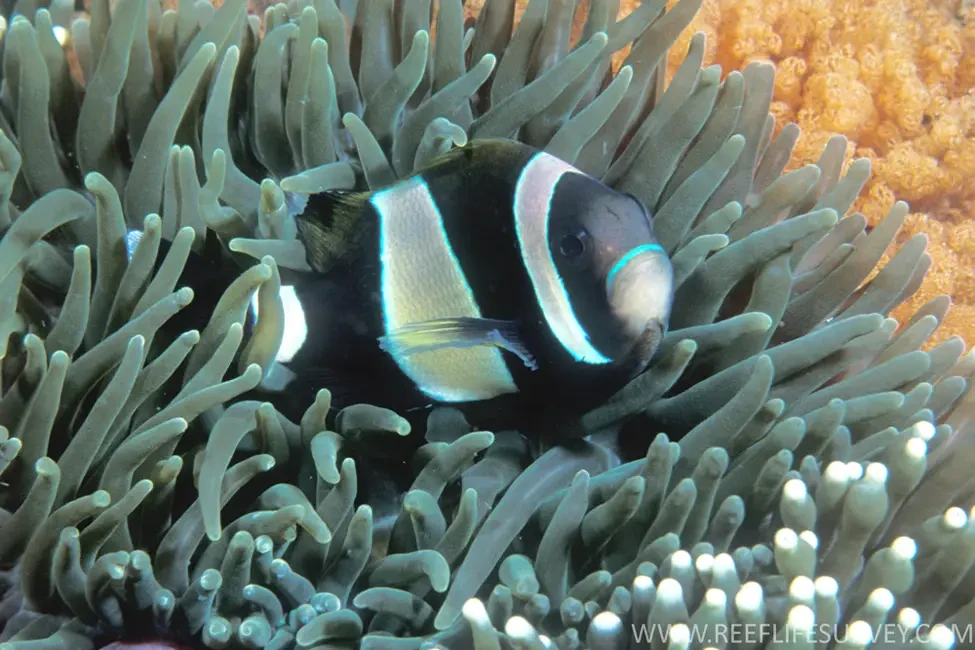Broadband Clown (Amphiprion latezonatus) is a unique representative of the Amphiprion genus, which is highlighted expressive white stripes and dark blue or black color. It is a rare and poorly studied species that lives only off the east coast of Australia, mainly in the waters of New South Wales and Queensland.
✔ Impressive color scheme with wide white stripes
✔ It lives in symbiosis with sea anemones
✔ One of the least common species in nature and in aquariums
✔ Demonstrates high territorial integrity and social organization
This article will cover all aspects of the broadband clown's life: from its appearance and behavior to threats to its existence and the possibility of keeping it in captivity.

Scientific classification
✔ The Kingdom: Animals (Animalia)
✔ Type: Chordal (Chordata)
✔ Class: Lucheperi pisces (Actinopterygii)
✔ Row: Perch-like (Perciformes)
✔ Family: Pomacentrovye (Pomacentridae)
✔ Gender: Amphiprions (Amphiprion)
✔ View: Amphiprion latezonatus
✔ Described: Allen, 1972
This species got its name due to wide white stripes ("latezonatus "means" broadband " in Latin), which are its main feature.
Habitat and habitat
🌏 Distribution:
🔹 Endemic to the Western Pacific Ocean
💥 Most often found near Australian coast
, Distributed from from Southern Queensland to New South Wales
🏝 Living environment:
Обит Inhabits on coral and rocky reefs
💥 Prefers depths of 5-30 m
💥 Picks specific anemone species for symbiosis, such as Stichodactyla haddoni
The species is very attached to its habitat and doesn't migrate, spending your entire life within the same reef.
Appearance and coloring
🎨 Main Features:
✔ Dark blue or black body
✔ Three wide white stripes:
* The first one is behind the eyes
* The second one is in the middle of the body
* Third-at the caudal stem
✔ Blue tint on white stripes
✔ The caudal fin is white, sometimes with a yellowish tinge
✔ Reaches a size of 14-16 cm
🎭 Sexual dimorphism:
✔ Females significantly larger than males
✔ If the dominant female dies, the largest male changes sex
Bright contrasts in color make this a clown one of the most attractive members of the Amphiprion genus.
Lifestyle and behavior
✅ Symbiosis with anemones
✔ Lives in close association with sea anemones
✔ Produces protective slimewhich makes it insensitive to stinging anemone cells
✔ Protects the anemone from predatory fish
✅ Social structure
✔ Live small groups (2-6 individuals)
✔ The group has dominant female, subordinate male, and juveniles
If the female dies, the male becomes the female, and the largest young becomes the new male
✅ Aggressiveness and territoriality
✔ Protects the anemone from other fish, even humans
✔ Does not migrate, spends all his life in one place
Food
🔹 Basic diet:
✔ Zooplankton
✔ Small crustaceans
✔ Seaweed
🔹 Nutrition features:
✔ Omnivorous fish that it hunts plankton and scrapes algae
✔ Sometimes eats leftover food anemones
Reproduction
🔹 Proteroginal hermaphrodite:
✔ Hatches as a male, but able to change gender
🔹 Spawning process:
✔ Female lays eggs 500-1500 eggs
✔ The male guards and cleans the clutch
✔ Larvae hatch via 6-10 days

Predators and threats
🔸 Natural enemies:
✔ Large predatory fish
✔ Octopus and moray eels
🔸 Main threats:
✔ Catch for the aquarium trade
✔ Destruction of coral reefs
✔ Climate change affecting anemones
The wideband clown is dependent on coral reefs, so their destruction can seriously affect the population of this species.
Keeping in aquariums
🟠 Popularity:
✔ Very much rare on sale
✔ Suitable for large marine aquariums
🟠 Aquarium requirements:
✔ Volume: from 150 liters
✔ Temperature: 24–27°C
✔ Salinity: 1.020–1.025
✔ The presence of anemone improves the conditions of detention
🟠 Compatibility:
✔ Peaceful sea fish
❌ You can't keep it with other clownfish!
This view needs experienced care and stable water parameters.
Interesting facts
🔹 One of the largest clownfish (up to 16 cm)
🔹 It has unique wide white stripes that other species do not have
🔹 It is rarely found in aquariums due to the complexity of maintenance.
🔹 It lives up to 15 years in nature and in captivity
Conclusion
Broadband Clown (Amphiprion latezonatus) – a rare and impressive view, which impresses with its color and behavior. Its existence is closely linked to anemones and coral reefs, and only the preservation of these ecosystems guarantees the future for this amazing species.
📢 Protecting reefs is the key to keeping clownfish alive! 🌊🐠💙